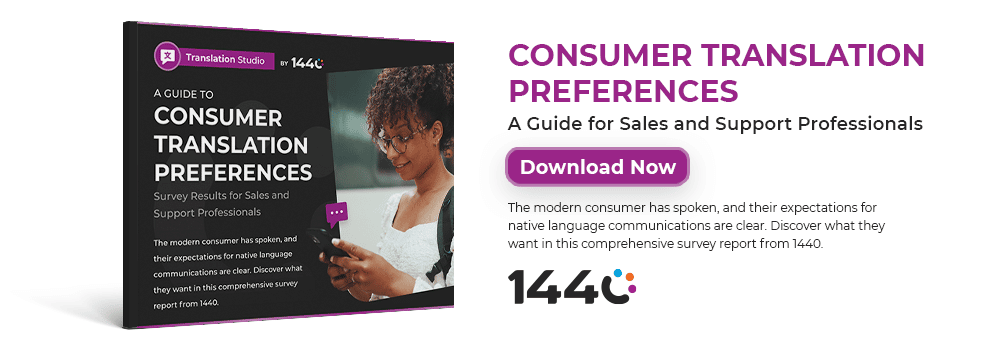5 Things Every Salesforce System Integrator Needs to Know About Business Translation

These days, many of the best, most highly regarded brands depend on the Salesforce platform to run their businesses. There, they manage all aspects of the customer lifecycle – from marketing to sales to service – and everything in between.
Salesforce understands that businesses aren’t one-size-fits-all. And one of the beauties of the platform is that it’s been built to be customized to meet the unique needs of just about any brand.
Oftentimes, businesses tap into System Integrators to ensure they’re getting the most from the Salesforce Platform. System Integrators, often referred to as Consulting Partners or simply SIs, help businesses build, configure, and optimize their Salesforce environment to ensure it’s meeting their needs.
Of course, SIs consider many things when helping to ensure a business’ Salesforce environment works for them. If you’re a global brand (or even if you’re not but have customers that speak different languages), translation must be one of those considerations.
In this blog, we’ll cover five of the top things your SI needs to know about business language translation in Salesforce.
#1 Modern Consumers Expect Native Language Support
Generic, one-size-fits-all experiences will no longer cut it. Instead, modern consumers expect personalized experiences throughout the purchase journey from brands that understand what they want and need. Per Salesforce’s State of the Connected Customer report, nearly three quarters (73%) of consumers expect companies to understand their unique needs and expectations.
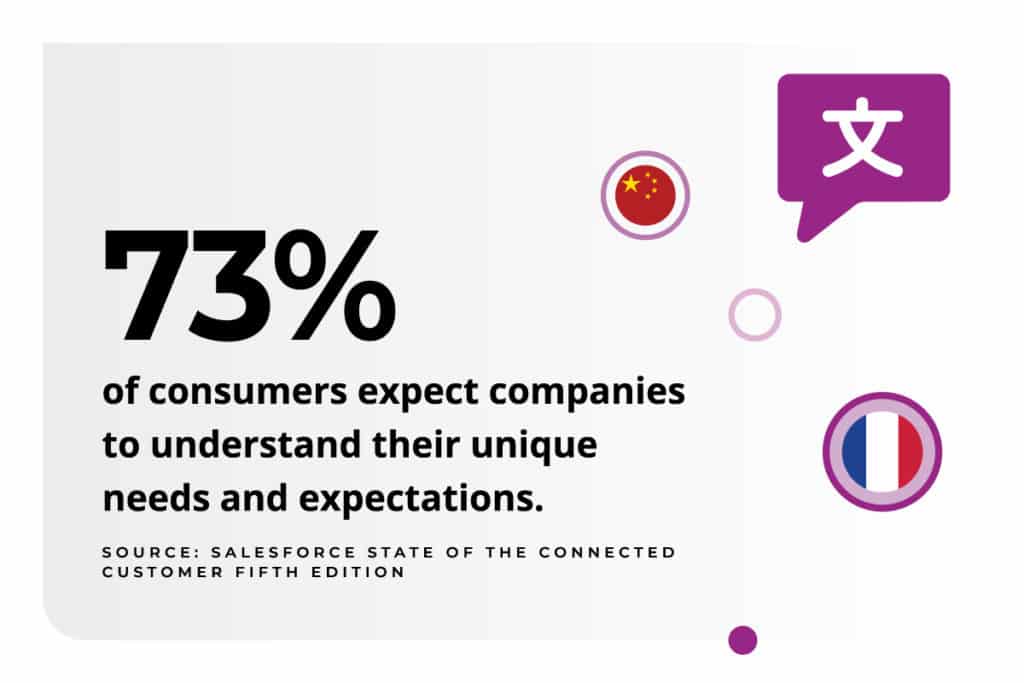
A big part of meeting these expectations is being able to effectively communicate with all customers, regardless of their preferred language.
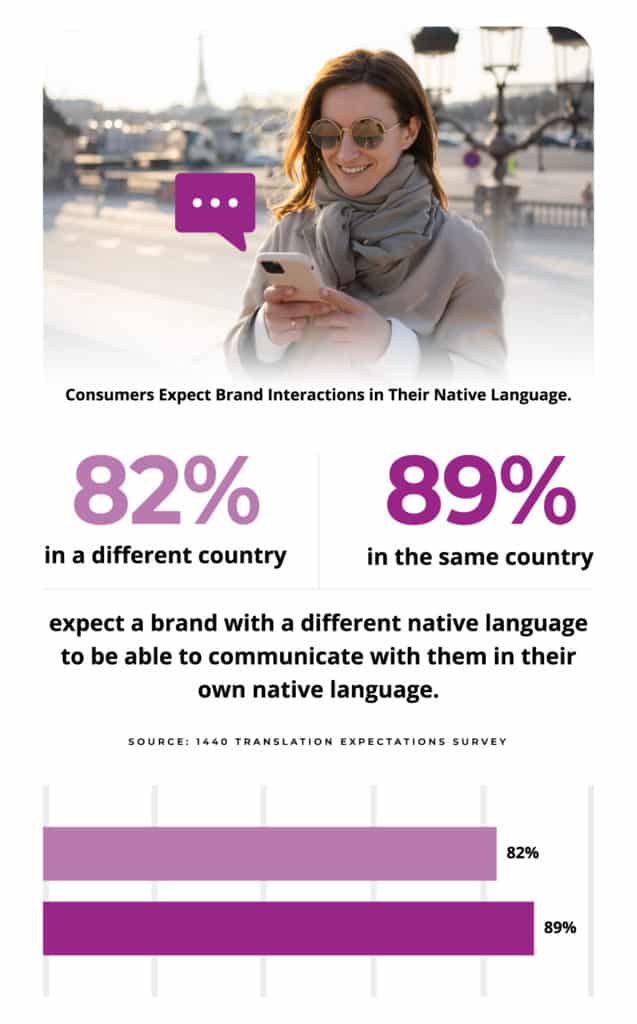
A recent survey from 1440 found that when consumers are interacting with a company from a different country with a different native language, 82% expect the company to be able to communicate with them in their own language at least sometimes. And 89% have this expectation when interacting with a brand in the same country with a different native language than theirs.
Consumers Expect Brand Interactions in Their Native Language
- 82% expect a brand in a different country with a different native language to be able to communicate with them in their own native language.
- 89% expect a brand in the same country with a different native language to be able to communicate with them in their own native language.
In fact, a brand’s ability to communicate with customers in their native language has a big impact on their ability to win and retain customers. CSA Research found that, if given the choice between buying two similar products, 76% will go with the option that has information in their native language. And three-quarters are more likely to make a repeat purchase from a brand if customer service is available in their native language.
A Brand’s Ability to Break Down Language Barriers Can Make or Break the Sale
- If given the choice between two similar products, 76% of consumers will choose the option that has information in their native language.
- 75% are more likely to make a repeat purchase from a brand if customer service is available in their preferred language.
Source: CSA Research
The pressure is on for brands to provide great support and experiences – regardless of language.
#2 Fast, Accurate Translation is Also Important for Internal Collaboration
There was once a time when it was the norm for a company’s entire customer care team to sit in the same office building in the same city. But that’s no longer the case.
Today, workforces are often geographically dispersed. This is especially the case for global brands. And even if the entire customer care team resides in the same country, they may still speak different languages.
Language barriers can make collaboration tricky. For example, an agent in Spain might have an interaction with a customer in Spanish. But later on, the customer contacts the company again and is paired with an agent in Germany who doesn’t speak Spanish. The case notes and chat history are all in Spanish – making it difficult for the German agent to get up to speed.
Fast, accurate translation is imperative to better internal collaboration. When employees have the tools they need to communicate with each other regardless of language, it improves outcomes. And that means they can work together to deliver great experiences to customers.
#3 Effective Business Translation Involves Many Salesforce Objects
Fast, accurate translation is necessary for better internal collaboration – and for delivering great customer experiences. But achieving these goals requires the ability to translate many different kinds of Salesforce objects.
Our recent survey found that consumers expect brands to be able to communicate with them regardless of language via numerous channels, including (but not limited to):
- Knowledge articles
- Chat bots
- Live chats
- Reviews and Q&A
- Websites
- SMS messages
That means brands must have a way to quickly and accurately translate these – among others.
In addition brands must be able to easily translate other objects to improve internal collaboration, including cases and chats, among others.
#4 Manually Translating with a Translation Engine Doesn’t Cut It
In the early days of machine translations, there were problems with things like nuance, word reflection, and word order. Translations sounded like machines – rather than humans.
These days, machine translation has improved a ton. You’re likely familiar with some of the top, readily available translation engines such as Google Translate and Microsoft. Maybe you’ve even used them in your everyday life.
But manually translating interactions with consumers isn’t an effective way to meet their expectations.
Our survey found that a large portion of consumers expect brands to be able to quickly translate communications via key channels. In fact, many expect instant translations.
Consumers Expect Fast Translations Across Channels
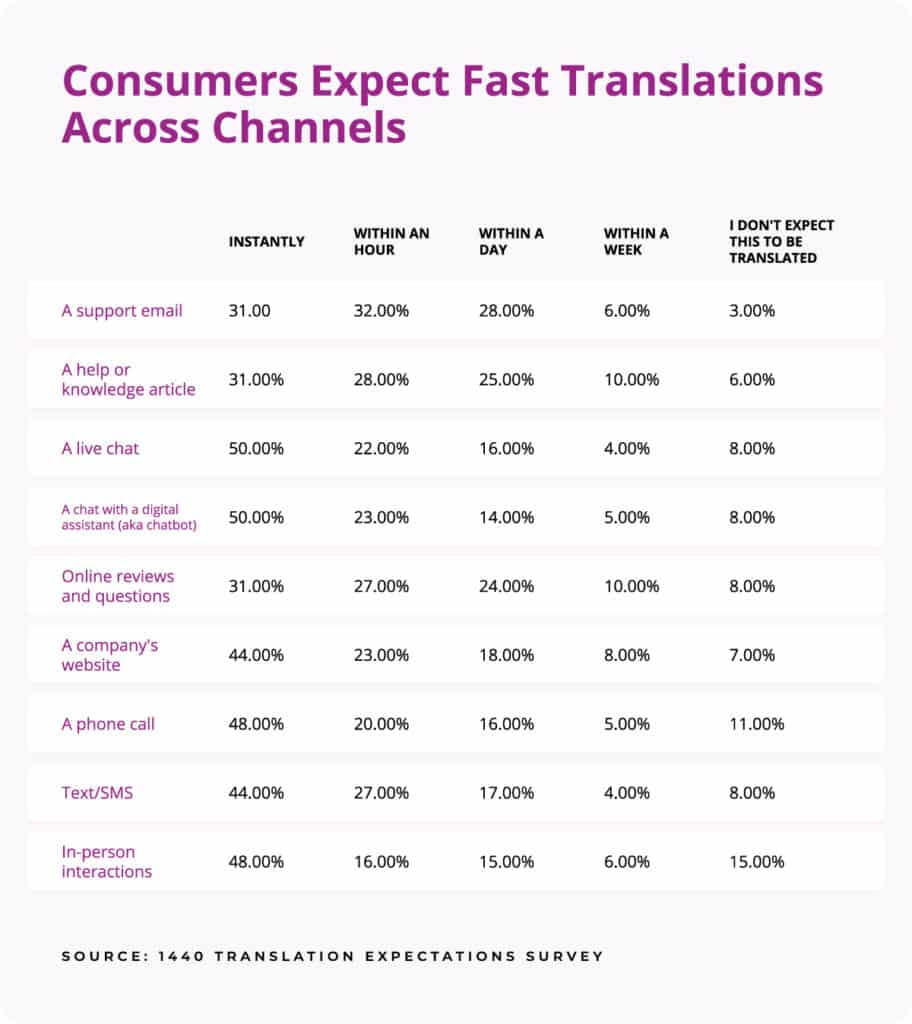
Copying and pasting text into a translation engine every time that a translation is needed isn’t exactly efficient. It’s time consuming – and it hampers a brand’s ability to meet (or even exceed) customers’ expectations.
#5 A Ready-Made Solution Translation Built for Salesforce is the Best Approach to Solving the Translation Challenge
Being able to run fast, accurate translations is a must for any brand. But manually running those translations isn’t sufficient. Brands must find a better solution for translating objects in Salesforce.
One option is for the brand to build a solution in-house. But this requires pulling resources off other critical projects. As an alternative, new resources can be recruited. But let’s face it – recruiting for technical roles isn’t exactly easy.
What’s more, building a homegrown translation solution creates technical debt, as the brand must fix issues, maintain, and iterate on the solution once it’s built.
A better approach is for brands to find a ready-made translation solution like Translation Studio from 1440.
A ready-made translation solution is proven; plenty of other customers that have already put it to the test. And because no development is required, brands can start getting value from it quickly.
What’s more, some translation solutions are built specifically for the Salesforce platform, which means they’ll seamlessly integrate into a brand’s Salesforce environment, improving both internal collaboration and external customer experiences.
Start Breaking Down Language Barriers
Modern consumers expect brands to be able to communicate with them – regardless of their language and channels of choice. Fast, accurate translations must be a focus of any brand.
Learn how winning brands are leveraging Translation Studio to improve internal collaboration and instantly communicate with customers in any language.
SE Enablement: Watch the Translation Studio Demo for SEs and SIs
In June of 2022 we had the pleasure of presenting Translation Studio to Salesforce Solutions Engineers and System Integrators. Watch the video below and check out our Demo Kit to see Translation Studio in action.
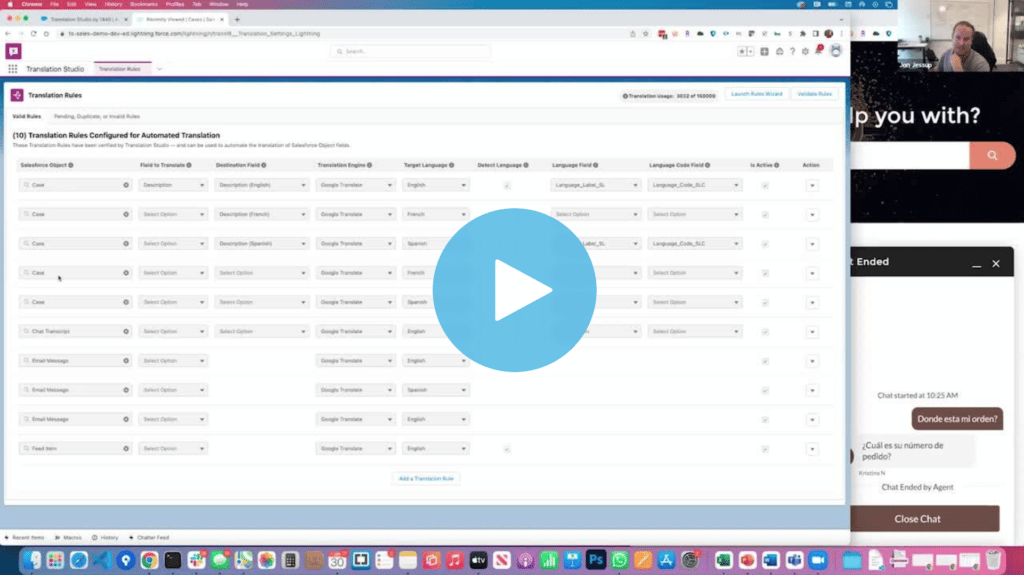
Get the Complete Survey Results
